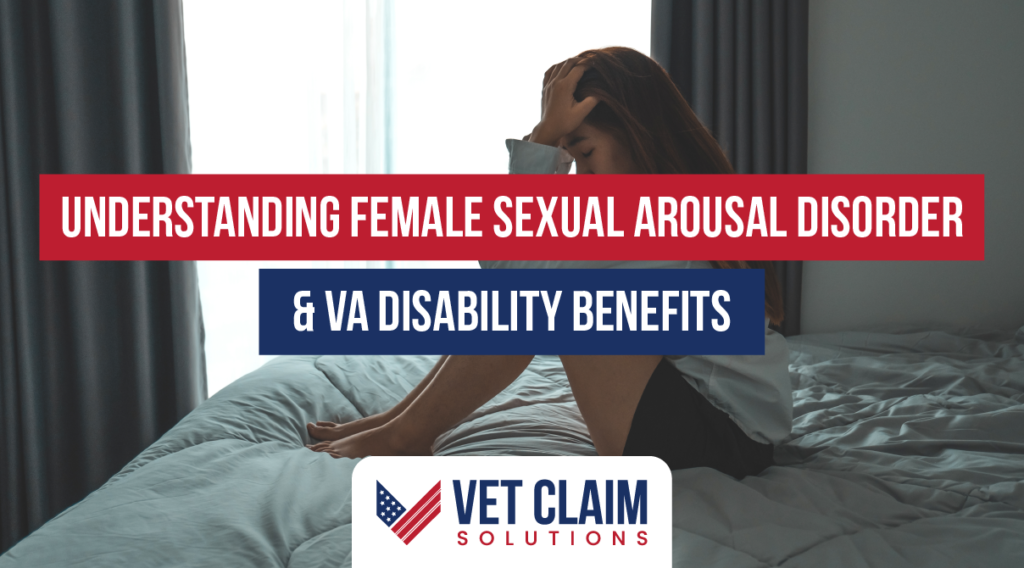Female Sexual Arousal Disorder, known as FSAD, often stays under the radar. But let’s face it—its effects are real and sometimes devastating for veterans. It’s not just about low sexual drive or difficulty getting into the mood; it’s an arousal disorder that can turn one’s world upside down.
What is Female Sexual Arousal Disorder (FSAD)?
Imagine wanting to start a car only to find out the engine won’t rev up—that’s kind of what FSAD feels like. Symptoms include trouble with sufficient sexual arousal despite desire and difficulty achieving orgasm, making intimate moments feel more frustrating than fulfilling.
Luckily, in September 2017, VA decided to recognize this condition by awarding VA disability benefits. So now female veterans experiencing these symptoms have a path to get help.
The Impact of FSAD on Veterans’ Lives

This isn’t just about what happens in the bedroom—it spills over into daily life. Relationships can strain; mental health might take a hit from conditions like depression or anxiety linked with ongoing stress due to sexual dysfunction issues.
To make matters worse, service-connected FSAD may tag along with other gynecological conditions or even neurological ones that add another layer of complexity for women who served our country bravely but now battle silent wars at home.
Navigating claims processes, understanding diagnostic codes relevant within veteran law contexts while managing day-to-day challenges—all part of deciphering what living with FSAD means when looking towards long-term care plans including potential healthcare professional consultations.
So yes: talking about female sexual function isn’t always comfortable—but we need these conversations because they lead us closer towards healing paths filled not just with hope but also tangible solutions tailored specifically around unique needs each individual faces post-service period timespan wise.
Key Takeaway:
FSAD is tough, but there’s hope for female vets—since 2017, they can claim VA benefits. Remember: it’s more than bedroom blues; it affects your whole life and mental health. Getting those monthly checks means proving the link between service and symptoms, which might be tricky but totally worth it.
Service Connection for Female Sexual Arousal Disorder
If you’re a veteran dealing with female sexual arousal disorder (FSAD), understanding how to establish service connection within the VA disability framework is crucial. Gaining the acknowledgment and aid you are entitled to isn’t just about completing forms – it’s a must.


Direct Service Connection Criteria
To pin down a direct service connection for FSAD, three things are needed: a current diagnosis, an in-service event that could have caused or aggravated the condition, and evidence of medical nexus linking them together. Let’s say during your time in uniform, military service put you under extreme stress or exposed you to chemical agents known as risk factors for developing FSAD—this may help show that necessary link between your condition and your honorable service.

Secondary Conditions Leading to Service Connection
Sometimes FSAD doesn’t stand alone—it often has companions making life harder than it should be. Mental health conditions such as depression or anxiety frequently walk hand-in-hand with this sexual dysfunction. These psychiatric conditions might either stem from living with FSAD or contribute further to its development after leaving active duty. Gulf War veterans, in particular, might find their complex web of health issues tied back to their time serving our country when trying to receive VA disability compensation for secondary connections.
Key Takeaway:
Struggling with FSAD? Prove a direct service connection by showing your diagnosis, linking it to an in-service event, and backing it up with solid medical evidence. Tough but doable.
Mental health issues like depression often tag along with FSAD. Show how they’re connected to military life for secondary VA benefits—it’s complex but possible with expert help.
Navigating the Compensation & Pension Exam Process
Getting ready for your C&P exam, especially when it’s about Female Sexual Arousal Disorder (FSAD), can feel like gearing up for battle. But fear not; a little prep goes a long way.
Preparing for Your C&P Exam

You’re stepping into this ring to show how FSAD impacts your life—so bring the evidence that packs a punch. Make sure you’ve got all medical records related to sexual arousal disorder, including notes from healthcare professionals who’ve witnessed your struggle firsthand. These aren’t just papers; they’re proof of your daily battles with symptoms that go beyond difficulty achieving orgasm and encompass an array of physiological findings/damage linked to this gynecological condition.
Show them what FSAD steals from you—not just in terms of sexual function but also how it infiltrates every aspect of normalcy, whether that’s social interactions or emotional well-being. If mental health conditions like depression anxiety have moved in as unwelcome houseguests because of FSAD, let those details be known too.
Acing the evaluation is partly about self-advocacy—being able to articulate clearly how these invisible wounds came from service-related experiences or are intertwined with other service-connected conditions such as blood vessel disease or neurological disorders.
Remember: This isn’t just any check-up; it’s where VA rates fsad and decides if special monthly compensation is warranted based on their rating schedule—which means every detail counts.
Evaluation Tips During The Exam

Your voice matters most during the exam itself. Be bold when discussing intimate details around female sexual dysfunction—you’re there because they need real talk on things like vaginal contact discomfort or arousal issues so severe they affect relationships and quality of life. Speak up loud enough so there’s no doubt left behind.
The VA disability compensation process might seem intimidating at first glance, but think about it as constructing a bridge between what happened in-service and its consequences now—a necessary step towards receiving va disability benefits due to female sexual arousal disorder .
Check out strategies for expressing yourself confidently during exams here.
Key Takeaway:
Gear up for your C&P exam by gathering solid evidence of how FSAD affects you. Show the real impact on your life, from social struggles to emotional turmoil. Speak up about all symptoms—your story builds the bridge to benefits.
Common Secondary Conditions Associated with Female Sexual Arousal Disorder
Female veterans dealing with FSAD often find themselves battling more than just this challenging condition. It’s not uncommon for them to face a cascade of health issues that tag along, complicating their road to wellness.

Mental Health Implications
The intertwining of sexual function and mental well-being is undeniable. For many women, the presence of FSAD can exacerbate or even trigger mental health conditions like depression and anxiety. The daily struggles these brave souls endure go beyond physical symptoms; they extend into realms where battles are invisible but equally grueling.
FSAD doesn’t march alone; it brings an entourage of psychological challenges, turning what should be moments of intimacy into battlegrounds fraught with emotional distress. Navigating through life while managing both female sexual dysfunction and its mental comrades requires resilience—a quality no stranger to our nation’s veterans.

Gynecological Conditions as Culprits
Beyond the mind lies a web of gynecological conditions intertwined with FSAD—conditions that can act as either risk factors or consequences. Think blood vessel disease obstructing the natural ebb and flow needed for sufficient sexual arousal, or neurological conditions pulling strings behind the scenes, disrupting signals meant for pleasure rather than pain.
Pain disorders during vaginal contact whisper tales about underlying gynecological mysteries waiting to be uncovered by healthcare professionals who understand the complex narratives woven by military service-related experiences.

The VA Rating Schedule’s Recognition
Veterans seeking disability compensation encounter a rating schedule sometimes difficult to navigate when addressing something as intimate as FSAD—which received recognition from VA in September 2017—and related secondary conditions. While navigating claims tied up in diagnostic codes may seem daunting at first glance, establishing service connection shows us how deeply interconnected different aspects of one’s health truly are.
To establish service connection: You need proof there was an event during your time on duty linked directly back home—something you can show without doubt has cast long shadows over your current diagnosis (1).
Key Takeaway:
FSAD in female veterans often leads to mental health struggles and gynecological issues, making the VA’s recognition of this condition crucial for accessing deserved benefits.
Establishing a Medical Nexus Between Military Service and Female Sexual Arousal Disorder
For veterans grappling with the invisible wounds of war, proving that their female sexual arousal disorder (FSAD) stems from military service can be as complex as the condition itself. The journey to getting VA disability benefits often hinges on one critical piece: establishing a medical nexus.
The Essentials of Proving an FSAD Connection

To start, understanding what we mean by ‘medical nexus’ is key. It’s essentially solid proof that your FSAD didn’t just appear out of thin air but has its roots in your time in uniform. This could mean connecting it to Agent Orange exposure, or chronicling how conditions at military burn pit locations played a role.
Your evidence must paint a clear picture showing the link between FSAD and incidents during service—a daunting task but not insurmountable with precise documentation. Think about it like building a bridge where every plank is an essential part of your medical history.
Digging Deeper into Your Service History for Clues

Sometimes, finding this connection requires playing detective through past experiences—be they psychological traumas or physical injuries—that may have been overlooked initially. Did you know that certain neurological conditions or even blood vessel diseases contracted during service could lead to FSAD later? Let’s say there was an incident resulting in significant stress; such emotional turmoil might lay the groundwork for future sexual dysfunction symptoms without obvious physiological findings/damage right away.
Mental health too plays its part; depression and anxiety aren’t just heavy burdens—they’re risk factors complicating sexual function, potentially giving rise to secondary conditions like FSAD after leaving active duty life behind.
Gathering Evidence Like Your Benefits Depend On It – Because They Do.

Finding healthcare professionals who understand both female sexual disorders and veteran issues will make sure you get sufficient clinical evidence backing up your claim—the kind that makes decision-makers sit up straighter when reviewing your case file. Plus, if there were any specific gynecological conditions diagnosed post-service linking back to events while enlisted? That’s more than mere coincidence—it strengthens the possibility of receiving VA compensation dedicatedly designed for those living with these challenges daily.
All said remember this isn’t merely about paperwork gymnastics—it’s fighting for recognition and monthly compensation you rightly deserve because yes, it’s your right. So make sure every form is filled out accurately and filed on time. This will help speed up the process and get you what you’re owed without unnecessary delays.
Key Takeaway:
Proving FSAD is service-connected means digging into your past and showing solid proof—like a detective linking every clue back to your military days. Find the right healthcare pro, gather all evidence meticulously, and file accurately to get the VA benefits you deserve.
The VA Rating System Explained for Female Sexual Arousal Disorder
When it comes to the VA rating system, female sexual arousal disorder (FSAD) stands out as a condition that can be tough to pin down. It’s like trying to nail jelly to a wall – complex and elusive. Yet, understanding how FSAD is rated by the VA is crucial for veterans seeking disability compensation.
Female sexual arousal disorder goes beyond bedroom woes; it’s about how this gynecological condition intertwines with one’s service and overall well-being. The VA acknowledges this connection through its diagnostic codes but doesn’t hand out ratings generously. In fact, unless there’s physical damage involved, FSAD typically receives a 0 percent rating under these guidelines.
If you’re picturing your claim going up in smoke because of that zero percent figure, hold on. When genitals have taken physical hits leading to blood vessel disease or neurological conditions—situations often more visible than FSAD—you might see those numbers climb if they fall under other related diagnostic codes.
Navigating Diagnostic Codes and Ratings
Now let’s get into the nuts and bolts of filing your claim: You’ll need evidence showing sufficient sexual arousal just isn’t happening due to your military service—a direct hit on daily life from something you experienced while serving our country.
To establish service connection for FSAD or secondary conditions like mental health issues stemming from it—think depression anxiety spirals—the puzzle pieces must fit perfectly together: current diagnosis meets in-service event meets medical nexus linking them all up. Like threading a needle in dim light, right? But when done correctly, establishing this link can lead not only towards monthly compensation but potentially special monthly compensation if severe enough impact is demonstrated.
Making Your Case with Medical Evidence
Gathering proof feels daunting—but think of yourself as Sherlock Holmes piecing clues together; each piece critical in painting the full picture for the VA rater assessing your case. If you’ve been around healthcare professionals post-service struggling with achieving orgasm or any form of pain during vaginal contact—it counts.
Free case evaluations can guide you through murky waters before plunging headfirst into documentation submissions.
So although invisible at first glance compared to say male veterans dealing with erectile dysfunction—which gets talked about way more—female vets grappling with female sexual dysfunction deserve their fair shake at receiving va disability benefits too.
Key Takeaway:
Don’t get discouraged by FSAD’s typically 0% VA rating. Show how it impacts your life, link it to service events and gather evidence like a detective—your fair compensation awaits.
Filing a Claim for VA Disability Benefits Due to Female Sexual Arousal Disorder
For female veterans, grappling with Female Sexual Arousal Disorder (FSAD) can be a challenging battle. But when it comes to filing a claim for VA disability benefits, knowing the right steps is crucial. FSAD includes symptoms like low sexual drive and trouble with arousal, which may stem from your service time. Good news: since September 2017, the VA recognizes this condition.
To kick things off, you’ll need some solid documentation backing up your FASD claim—think medical records that pinpoint FSAD as well as any ties it has to your military stint. The trick here isn’t just proving you have FSAD; it’s showing how it connects to what happened during your service or how another service-connected health issue might’ve sparked it.
Remember those C&P exams? For an evaluation of FSAD symptoms they’re not exactly everyone’s cup of tea but getting through one successfully means being open about what you’re experiencing. And hey—if there are other issues playing tag-along with your FSAD like depression or anxiety—they count too.

Direct Service Connection Criteria
Diving into the direct connection part means looking at three key pieces: current diagnosis of FSad from a healthcare professional; proof something in-service kicked things off; and lastly—a medical nexus linking these two together firmly.
If we chat secondary conditions for a sec—you’ve got stuff like mental health concerns or even blood vessel disease that could either cause or worsen your experience with FSA due their relationship with hormonal imbalances and overall wellbeing after serving our country.

Secondary Conditions Leading to Service Connection
Sometimes complications come along after exiting the forces which can exacerbate existing problems—or start new ones entirely. It’s worth exploring if any additional gynecological conditions surfaced post-duty because they could help establish that critical connection between daily life hassles caused by FSAD and previous service commitments.
Vet Claim Solutions offers free case evaluations, so don’t hesitate if piecing all this together sounds more complicated than putting together Ikea furniture without instructions—we get it.
Take heart in knowing every form filled out moves you closer toward receiving va disability compensation designed specifically for American heroes who’ve worn their country’s uniform proudly—but now face unique challenges back home.
Key Takeaway:
Start your VA disability claim for FSAD by gathering medical evidence linking it to your service. Remember, both direct and secondary conditions count. If you’re stuck, free case evaluations can guide you through the process.
Mental Health Implications of Living with Female Sexual Arousal Disorder
Living with FSAD can go beyond being a gynecological issue and be linked to psychological problems. The daily battle can feel like carrying an invisible weight, affecting everything from self-esteem to interpersonal relationships.
Mental Health Conditions Associated with FSAD

Living with FSAD isn’t just about the physical symptoms—it’s also a mental and emotional marathon. Women veterans may find themselves grappling not only with their sexual dysfunction but also fighting off depression, anxiety, or other psychiatric conditions that stem from this deeply personal struggle. These co-occurring issues underscore why comprehensive care for both body and mind is critical in these cases.
The connection between FSAD and mental well-being goes beyond cause-and-effect; they fuel each other in a relentless cycle. For many female veterans dealing with this disorder, the frustration of insufficient sexual arousal morphs into something darker—feelings of inadequacy that seep into every corner of life.
Treatment Options That Address Both Physical and Mental Aspects

To break free from the clutches of FSAD-related stressors requires addressing both physiological findings/damage and psychological scars left by living through such intimate challenges. Engaging healthcare professionals who understand how intertwined sexual function is with overall happiness becomes essential here. Treatment options span medication to counseling sessions tailored toward rebuilding confidence within one’s sexuality—and subsequently, their identity as a whole.
Therapies focus on helping women reclaim control over their bodies while providing tools to manage any associated mental health condition effectively. Because let’s face it: achieving orgasm should be part of enjoying life fully—not another hurdle to clear after service.
Finding Support Beyond Clinical Settings

Sometimes what helps most doesn’t come in prescription form but through solidarity found among fellow American veterans facing similar hurdles—a testament that you’re not alone on this journey back towards wholeness. Support groups, either online or locally organized ones specifically designed for military servicewomen experiencing FASD, include invaluable peer support mechanisms where shared experiences bring healing insights nobody else could offer quite as authentically.
In summing up the intricacies involved when your sex life hits rough waters because sometimes laughter really is good medicine: if your boat’s rocking too much—or worse yet—not enough? Remember there are resources ready at bay to help smooth out those waves.
FAQs in Relation to Va Disability Benefits for Female Sexual Arousal Disorder (Fsad)
1. Does the VA pay for female sexual dysfunction?
The VA offers disability compensation for conditions like FSAD if linked to service.
2. What are the criteria for FSAD?
To meet FSAD criteria, you’ll need symptoms like low arousal and evidence of impact on your life.
3. What is an example of a female sexual dysfunction according to the DSM?
The DSM lists several dysfunctions; one is Female Orgasmic Disorder, distinct from arousal issues.
4. What is the difference between a sexual disorder and a sexual dysfunction?
A disorder refers broadly to persistent problems in sexual response or pain during sex. Dysfunction typically means specific performance issues during sex.
Conclusion
Arm yourself with knowledge, and the path to VA Disability Benefits for Female Sexual Arousal Disorder (FSAD) becomes clearer. Remember: a direct service connection is key. Understand that your daily life matters—how FSAD affects you counts.
Keep your records straight; they tell your story during C&P exams. Realize secondary conditions might play a role—they’re part of the bigger picture too.
Navigate claims with confidence; every document has its place in building your case. Know that mental health support is there—as crucial as physical treatment.
Acknowledge the struggle, but also embrace hope—for benefits, for understanding, and most importantly, for improvement in quality of life.


